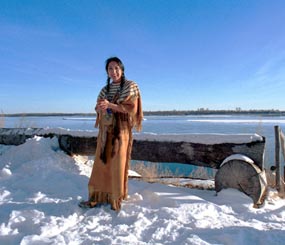 |
| NPS photo | | Amy Mossett as Sacagawea. |
 |
Imagine yourself a teenager – just 16 or 17 years old. Could you lead visitors through your old neighborhood, a place you had last seen as a child of 11 or 12? Could you also care for your spouse and newborn baby? Sacagawea, the only woman to travel with the Corps of Discovery, did this and more.
In 1804, Sacagawea was living among the Mandan and Hidatsa, near present day Bismarck, North Dakota. Approximately four years earlier, a Hidatsa raiding party had taken Sacagawea from her home in Idaho and from her people, the Lemhi Shoshone. Living among the Mandan and Hidatsa, Sacagawea married French trader Toussaint Charbonneau. In February of 1805, she gave birth to a baby boy, her first child. Captain Lewis recorded the event in his journal: “about five o’clock this evening one of the wives of Charbono was delivered of a fine boy.”
Two months after the birth of her son, Sacagawea left the Mandan and Hidatsa villages to journey west with the Corps of Discovery. While Sacagawea is often remembered as the guide who led the Corps across the plains, Expedition journals offer little evidence of this. Historians generally believe that Sacagawea joined the Expedition because her husband had been hired as a translator. Still, Sacagawea contributed significantly to the success of the journey.
Simply because she was a woman, Sacagawea helped the Corps. Among the tribes the explorers met, her presence dispelled the notion that the group was a war party. William Clark explained that “the Wife of Shabono [Charbonneau]…reconciles all the Indians, as to our friendly intentions. A woman with a party of men is a token of peace.”
Once the Corps reached Idaho, Sacagawea’s knowledge of the landscape and the Shoshone language proved valuable. The Corps was eager to find the Shoshone and trade with them for horses. The success of the journey hinged on finding the tribe: without horses the explorers would be unable to get their supplies over the mountains. Recognizing , Sacagawea reassured the explorers that the Shoshone - and their horses - would soon be found. When the Expedition did meet the Shoshone, Sacagawea helped the Corps communicate, translating along with her husband.
As the Corps traveled eastward in 1806, returning to St. Louis, they stopped again at the Mandan and Hidatsa villages. There Sacagawea and her family ended their journey. Historians have debated the events of Sacagawea’s life after the journey’s end. Although opinions differ, it is generally believed that she died at Fort Manuel Lisa near present-day Kenel, South Dakota. At the time of her death she was not yet 30.
More information about Sacagawea is available in the following books and web sites.
Books for adults
Sacajawea
Written by Harold P. Howard and published by University of Oklahoma Press.
The Fate of the Corps, What Became of the Lewis and Clark Explorers After the Expedition
Written by Larry E. Morris and published by Yale University Press.
Books for children
I Am Sacajawea, I Am York : Our Journey West with Lewis and Clark
Written by Claire Rudolf Murphy and illustrated by Higgins Bond. Published by Walker and Company.
Web sites
Information about Sacagawea dollar coin and biography of Sacagawea from the U.S. Mint
PBS site with biography of Sacagawea
| 





